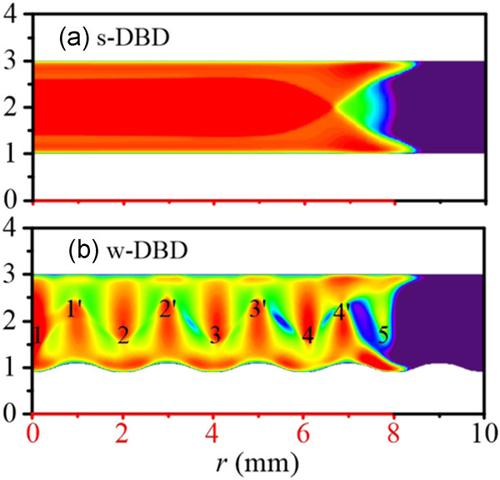当前位置:
X-MOL 学术
›
Plasma Processes Polym.
›
论文详情
Our official English website, www.x-mol.net, welcomes your
feedback! (Note: you will need to create a separate account there.)
How does the moderate wavy surface affect the discharge behavior in an atmospheric helium dielectric barrier discharge model?
Plasma Processes and Polymers ( IF 2.9 ) Pub Date : 2019-12-04 , DOI: 10.1002/ppap.201900182 Qiao Wang 1 , Wenjun Ning 1 , Dong Dai 1 , Yuhui Zhang 1
Plasma Processes and Polymers ( IF 2.9 ) Pub Date : 2019-12-04 , DOI: 10.1002/ppap.201900182 Qiao Wang 1 , Wenjun Ning 1 , Dong Dai 1 , Yuhui Zhang 1
Affiliation

|
A conventional parallel‐plate dielectric barrier discharge (DBD) model but with one dielectric layer having a wavy surface is purposely built for better understanding the plasma–surface interaction. The results of simulation under a kilohertz‐level alternating current voltage source indicate that the surface tends to impair the discharge uniformity and stimulate complementary filamentation. Upon analyzing the detailed transient processes, it is found that the alternations of filament positions in positive and negative discharges are mainly attributed to the local residual electrons and the electric field distortion near the wavy surface. Furthermore, the trends of discharge intensity and filament number under the variation of surface fluctuation are also revealed. The conclusions drawn here are general and would be helpful in understanding the plasma–surface interaction of the DBD with surface fluctuation.
中文翻译:

中性波浪形表面如何影响大气氦介电势垒放电模型中的放电行为?
为了更好地理解等离子体-表面的相互作用,特意建立了一个传统的平行板介电势垒放电(DBD)模型,但其中一个介电层的表面呈波浪形。在千赫兹级交流电压源下的仿真结果表明,表面趋于削弱放电均匀性并刺激互补的丝状化。通过分析详细的瞬态过程,发现正放电和负放电中灯丝位置的交替主要归因于局部残余电子和波状表面附近的电场畸变。此外,还揭示了在表面起伏变化下的放电强度和细丝数量的趋势。
更新日期:2019-12-04
中文翻译:

中性波浪形表面如何影响大气氦介电势垒放电模型中的放电行为?
为了更好地理解等离子体-表面的相互作用,特意建立了一个传统的平行板介电势垒放电(DBD)模型,但其中一个介电层的表面呈波浪形。在千赫兹级交流电压源下的仿真结果表明,表面趋于削弱放电均匀性并刺激互补的丝状化。通过分析详细的瞬态过程,发现正放电和负放电中灯丝位置的交替主要归因于局部残余电子和波状表面附近的电场畸变。此外,还揭示了在表面起伏变化下的放电强度和细丝数量的趋势。











































 京公网安备 11010802027423号
京公网安备 11010802027423号